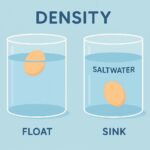Have you ever wondered how a small amount of soap can propel a toy boat across a puddle of water? This fascinating phenomenon is rooted in the concept of surface tension, a fundamental property of liquids that plays a crucial role in many natural and scientific processes. In this blog post, we’ll delve into the science behind the soap boat experiment, exploring how surface tension works, the physics of propulsion, and the practical applications of this intriguing concept.
What is Surface Tension?
Surface tension is a physical property of liquids that causes them to behave as if they have an elastic skin at their surface. It is caused by the cohesive forces between the molecules of the liquid. In water, for instance, each molecule is attracted to its neighboring molecules, creating a sort of “skin” at the surface. This skin is strong enough to support small objects, like a paper clip or a soap boat, despite their weight.
Surface tension is responsible for many everyday phenomena, such as the way water beads on a waxy surface or the ability of certain insects to walk on water. It is measured in units of force per unit length (e.g., newtons per meter) and is temperature-dependent, decreasing as the temperature increases.
The Soap Boat Experiment
The soap boat experiment is a classic demonstration of surface tension and its effects. Here’s a simple setup for the experiment:
1. Materials Needed:
- A small plastic or paper boat
- A container of water
- Dish soap
- A spoon or dropper
2. Setup:
- Fill the container with water.
- Place the boat gently on the surface of the water.
- Dip the spoon or dropper into the soap and place a small amount on the back of the boat.
3. Observation:
- The boat will begin to move across the water surface, propelled by the action of the soap.
How Does It Work?
The propulsion of the soap boat is a result of the reduction in surface tension caused by the soap. Here’s a step-by-step explanation:
1. Initial State:
- The boat is placed on the water, where the surface tension is at its natural level.
- The cohesive forces between water molecules create a sort of elastic skin.
2. Introduction of Soap:
- When soap is added to the water, it disrupts the cohesive forces between the water molecules.
- Soap molecules have both hydrophilic (water-attracting) and hydrophobic (water-repelling) ends. The hydrophilic end is attracted to water, while the hydrophobic end repels it.
- This disruption reduces the surface tension of the water.
3. Propulsion:
- The reduction in surface tension at the back of the boat creates an imbalance in the surface tension forces acting on the boat.
- The area behind the boat has lower surface tension, while the area in front has higher surface tension.
- This gradient in surface tension generates a net force that propels the boat forward.
The Physics Behind Surface Tension Propulsion
The propulsion of the soap boat can be explained by the principles of surface tension and the Marangoni effect. The Marangoni effect refers to the movement of a liquid caused by a gradient in surface tension. In the case of the soap boat, the gradient is created by the addition of soap, which lowers the surface tension at the back of the boat and causes the boat to move forward.
Cohesion and Adhesion
Cohesion and adhesion are two key concepts that underpin the phenomenon of surface tension:
- Cohesion: The attraction between like molecules. In water, cohesion is the result of hydrogen bonding between molecules.
- Adhesion: The attraction between unlike molecules. This is what causes water to spread out on certain surfaces, like glass.
When soap is introduced, it disrupts the cohesive forces between water molecules, leading to a reduction in surface tension. This disruption is what allows the soap boat to move.
Real-World Applications of Surface Tension Propulsion
While the soap boat experiment is a simple demonstration of surface tension propulsion, the principles involved have real-world applications in various fields:
1. Cleaning Agents:
- Soap and detergents rely on surface tension reduction to effectively clean surfaces. By lowering the surface tension of water, they are able to penetrate and lift dirt and grime more efficiently.
2. Medical Applications:
- Surface tension plays a role in certain medical applications, such as drug delivery systems and wound healing. Understanding how surface tension can be manipulated can lead to more effective treatments.
3. Aerospace Engineering:
- The Marangoni effect is studied in the context of fluid dynamics, particularly in the behavior of fluids in microgravity environments.
4. Environmental Science:
- Surface tension is important in understanding the behavior of pollutants in water and the effectiveness of cleaning agents in environmental remediation.
Conclusion
The soap boat experiment is a simple yet powerful demonstration of the principles of surface tension and the Marangoni effect. By understanding how soap disrupts the cohesive forces between water molecules, we can gain insights into the behavior of liquids and the potential applications of surface tension manipulation. Whether you’re a student, teacher, or simply someone curious about the natural world, the soap boat experiment offers a fascinating glimpse into the science behind everyday phenomena.

Posted inEveryday Science


